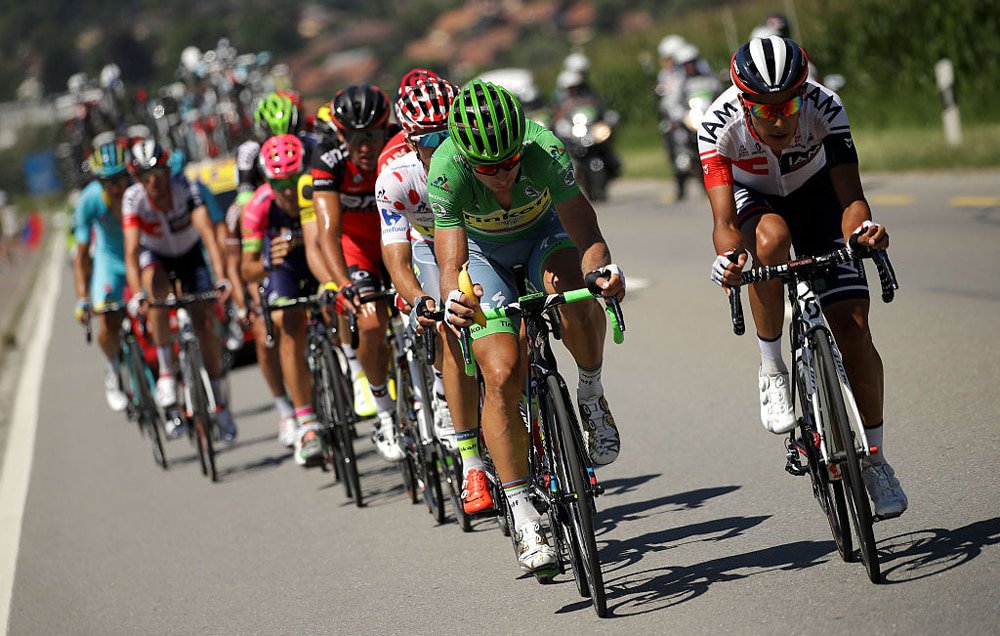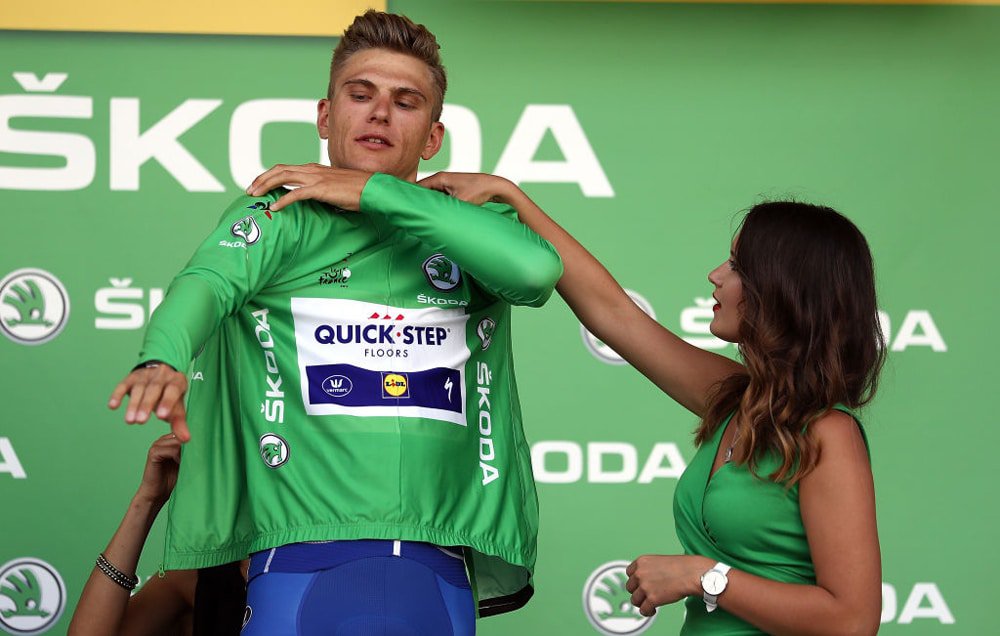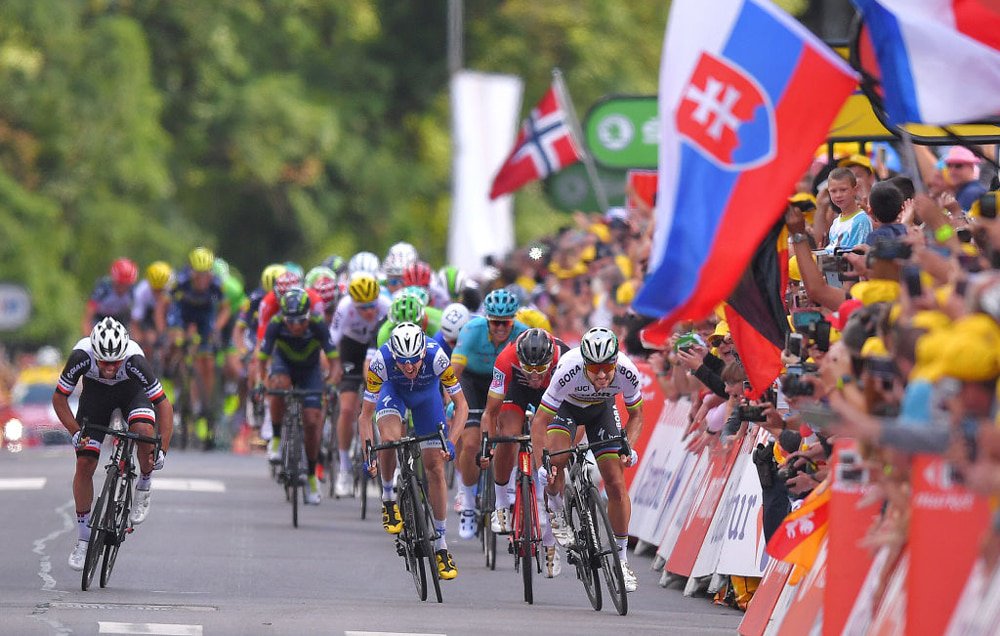Can Anyone Crack Peter Sagan’s Green Jersey Code?
Peter Sagan may not care that much about the Tour de France sprints points competition, but he’s certainly well-positioned for it just the same.
Peter Sagan may not care that much about the Tour de France sprints points competition, but he’s certainly well-positioned for it just the same. – By Joe Lindsey

Here’s the breakdown:
Intermediate sprints (points from 1st to 15th rider):
20-17-15-13-11-10-9-8-7-6-5-4-3-2-1
Stage Finishes
Sprint stage (points from 1st to 15th rider):
50-30-20-18-16-14-12-10-8-7-6-5-4-3-2
Medium Stage (points from 1st-15th rider):
30-25-22-19-17-15-13-11-9-7-6-5-4-3-2
There are also points on offer for the mountaintop finishes, but those will likely not factor for any rider in the top of the points competition standings. Most days, you can count on breakaways to gobble up the bulk of the intermediate sprint points.
So the rules put added weight on traditional flatter stages likely to end in sprints, and slightly de-emphasise medium stages like yesterday’s. Theoretically, that puts Sagan—who can win stages like that and win or podium in traditional sprints—on slightly more of a level playing field to classic sprinters who don’t feature on hilly finishes. That’s the theory, anyway.
With his win yesterday, Sagan upped his career Tour stage victory total to eight, and also jumped up the leaderboard in the green jersey competition, where he’s now third. As in the past, the challengers could come from a wide array of riders. We might have looked to a rider like Michael Matthews, for example, because he’s broadly similar to Sagan in capability and riding style. But this year, if someone unseats Sagan, look for it to be a classic field sprinter in the mold of Mark Cavendish or Marcel Kittel.

This year’s Tour has roughly similar numbers of likely sprint stages to each of the previous five editions (there are nine, including yesterday’s Stage 2). Typically, at least one stage per year that looks like a sprint ends up getting foiled by a breakaway attempt.
Last year, Cavendish won four stages and was the only rider within shouting distance of Sagan on points, but he dropped out after Stage 16 (a planned DNF so he could recover in time for the Rio Olympics, where he raced on the track). Sagan responded with three stage wins. No other sprinter won more than one.
But all three of Sagan’s wins were not fully straightforward bunch sprints. Stage two, into Cherbourg, finished on a short climb, much like this year’s Stage 3. Sagan’s competition there didn’t include the classic sprinters like Kittel and Cav, or Andre Greipel. On Stage 11, Sagan snuck off the front in late crosswinds and finished clear of the chasing bunch by six seconds.
Conditions that day were crucial. Cavendish didn’t make the front group in the crosswind split and scored no points. And Sagan’s breakaway mates: teammate Maciej Bodnar and overall leader Chris Froome, hoovered up the points for second and third place, leaving sprinters like Greipel and Alexander Kristoff to fight over the scraps. Only Sagan’s Stage 16 win into Bern was anything close to a true bunch finish, and even that featured a climb at 1.5km to go that thinned out the field some.
That’s not a knock on Sagan; the reason he’s won five straight green jerseys, after all, is that he can excel in such a broad variety of situations. But it is a reminder that no small part of the way stages play out is down to fortune, and those outcomes can multiply gaps in competitions like the points jersey.
As in past years, the competition early on is tight, but that’s not necessarily an indicator of anything. Sagan doesn’t usually take the jersey early in the race, instead assuming it in the second week as his consistency begins to accumulate a points lead that becomes ultimately insurmountable.
Right now, the clearest threat to Sagan is Kittel, the Stage 2 winner and current green jersey holder. Kittel is a pure field sprinter; he won’t figure in uphill finishes like yesterday’s. But, there aren’t many of those this year. Stages 4, 6, 7, 10, 11, 19 and 21 are all pretty flat. And Kittel is the type of sprinter whose wins tend to run in streaks. Aside from last year, with a single stage win, he took four each in 2013 and 2014. His Quick-Step team is largely built around him, and it also excels in classics-like conditions of rain and crosswinds, which we saw on Stage 2.

Another to watch is French sprinter Arnaud Démare of FDJ. Démare was second to Kittel on Stage 2, and finished sixth on Stage 3, a surprisingly strong result from a larger rider not known for his climbing skills. Démare has great form right now; he also won the recent French national championships. German Andre Greipel of Lotto-Soudal is always reliable for a victory—he’s won at least one stage of the Tour for the past six editions—but has never won a green jersey (he finished second, twice, to Sagan).
RELATED: Check Out Peter Sagan’s Custom Specialized S-Works Tarmac
The wild card has to be Cavendish, who is the winningest field sprinter in Tour history with 30 career stage wins. Pre-race, Cavendish said that in a normal year he’d expect to win four or more stages and surpass Eddy Merckx for most career stage wins (of any kind). But he’s struggled recently with Epstein-Barr virus and hasn’t raced much this season.
Sagan, meanwhile, will try for stage wins on the sprint stages, but may also score points on hillier days that take the bigger riders like Kittel out of contention: days like Stages 14 and 15, where he could sit in with the main pack and win out of a reduced bunch. He’ll face challenges there from riders like Matthews and Greg Van Avermaet of BMC, but Sagan has consistently proved the best on those kind of days.
It’s a long way yet to Paris and anything can happen. But this year’s Tour, with a course tilted to field sprinters and fewer medium stages with uphill finishes, might be the one that break’s Sagan’s streak.
READ MORE ON: People Peter Sagan tdf Tour de France

